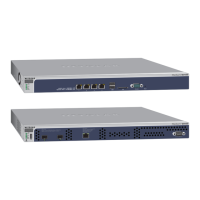Discover and Manage Access Points
158
ProSAFE Wireless Controller
• UDP port 7892. Used for access point registration with the wireless controller
after discovery.
• UDP port 7893. Used for access point registration with the wireless controller
during multicast discovery.
• Enable DHCP option 43 (vendor-specific information) on the DHCP server. Specify the
wireless controller’s IP address to allow the access points to receive the wireless
controller’s IP address and the DHCP server to assign IP addresses to the access points.
The DHCP server on the wireless controller automatically enables DHCP option 43 with
its own IP address.
• Convert access points behind a NAT router to managed access points and then install
them behind the NAT router.
• Assign each access point an IP address. All access points that are the same model ship
with the same default IP address. Except for access points in the factory default state that
are in the same Layer 2 network at the remote site, if two or more access points are
assigned the same IP address, then only one of them is discovered at a time. You must
add the access point to the managed list, change its IP address, and then run discovery
again to discover the next access point with that IP address.
• An access point must run at least its initial firmware release or a newer version. No other
firmware requirements exist for the access point to function with the wireless controller.
Tip: For management and monitoring purposes, make sure that you give
remote access points at one site the same location name and that you
create and assign meaningful building and floor names. For information
about creating building and floor names, see Manage a Building and
Floors for an RF Plan on page 56. For information about assigning
location, building, and floor names, see Change Access Point
Information on the Managed AP List on page 170.
Limitations After Discovery
The following limitations apply after remote access points are discovered:
• Seamless Layer 2 roaming is supported for the clients of a remote access points, but
seamless Layer 3 roaming is not supported for the clients across remote access points.
When clients move from one IP subnet to another at the remote site, they are
disconnected from their access point and must reconnect to another access point.
• If a remote access point is disconnected from the wireless controller, for example,
because the VPN connection goes down, the following occurs:
- The remote access point uses its last known configuration and functions as a
standalone access point while continuously attempting to reconnect to the wireless
controller.
- If the access point uses WPA-PSK, WPA2-PSK, or WPA-PSK & WPA2-PSK
authentication, it can continue to accept new clients. If the access point uses RADIUS
authentication with the local RADIUS server of the wireless controller instead of an
external RADIUS server, the access point can no longer accept new clients.

